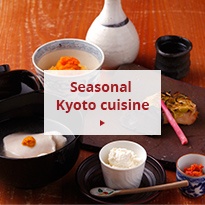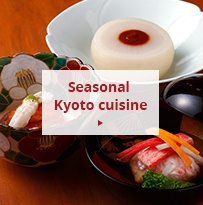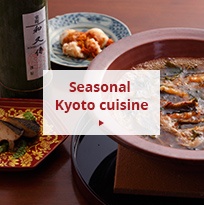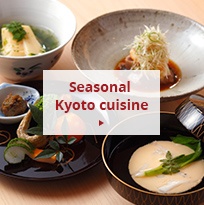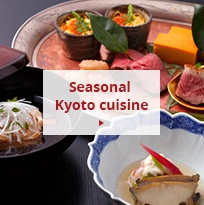What makes Kyoto's kappo restaurants so exceptional?
Golden broth soups, gleaming in soft light. Bright seasonal vegetables topped with thick Kudzu sauce. Traditional confections and matcha green tea. Renowned master chefs put their whole hearts and souls into every detail of the culinary experience to deliver unforgettable service and cuisine at Kyoto's finer kappo (intimate counter) restaurants.
 En
Only the best. A story of transformation.
En
Only the best. A story of transformation.
 Gion Owatari
Even the flavor of water is taken into account.
Gion Owatari
Even the flavor of water is taken into account.
 Muromachi Wakuden
Rustic yet refined. The essence of Kyoto Cuisine
Muromachi Wakuden
Rustic yet refined. The essence of Kyoto Cuisine
 Gion Aji Fukushima
Quality pursued with passion in today's Kyoto.
Gion Aji Fukushima
Quality pursued with passion in today's Kyoto.
 Wagokoro Izumi
The very soul of Kyoto culture and cuisine.
Wagokoro Izumi
The very soul of Kyoto culture and cuisine.
En縁

Phone: 075-411-1822
- Address:
- 589 Tatsumae-cho (South of Karasuma Ichijo Intersection), Kamigyo-ku, Kyoto-shi, Kyoto
- Open:
- Lunch 12:00 to 14:00
Dinner 18:00 to arrival no later than 21:00 - Closed:
- Thursdays and the last Wednesday of the month
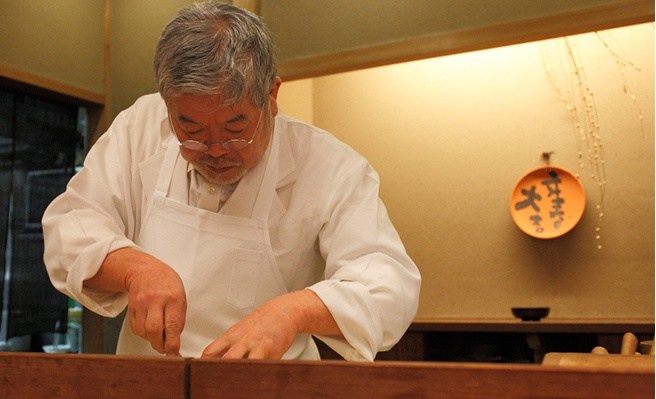
Takeo Suzuki, the owner-chef, honed his skills at various renowned restaurants including Hyotei since the age of 18. He laughs and says, “When you reach my age, you perform your best when being honest with yourself. Self deception leads you astray."
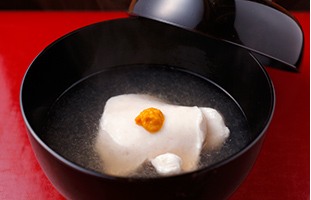
Seasonal Owan (soup) with globe fish roe and ground kabura (turnips) topped with kuzu sauce.
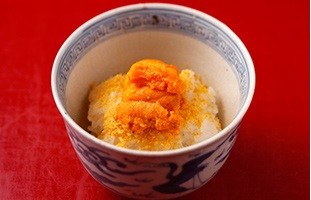
Steamed rice with generous portions of sea urchin and salted, "homemade" mullet roe.
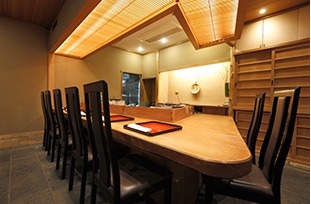
Comfortable yet cozy, the restaurant seats 7, allowing chef Suzuki to shower every guest with attention and timely service.
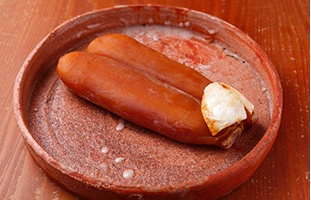
Soft Karasumi (dried mullet roe) dried and prepared by chef Suzuki. He carefully prepares every dish himself from scratch.
Only the best. A story of transformation.
En’s owner chef, Takeo Suzuki, launched his career at Kyoto’s prestigious Hyotei restaurant. He then vaulted to fame by opening his own shop with an avant-garde interpretation of Japanese cuisine, using non-traditional ingredients like game meat and foie gras. Upon moving his restaurant closer to the Kyoto Imperial Palace in 2008, he began suffering health problems that changed his cooking philosophy. The transformation also inspired him to open up the kitchen and interact with customers.
"I still use wild duck or quail at times, but I prefer keeping it simple rather than playing the eccentric artist. Now I pay more attention to the preparation of dishes from the very beginning." Among his favorites are So, Japan’s ancient cheese, which is made from milk and reminiscent of mascarpone; steamed rice with sea urchin and salted mullet roe; and preserved Yubeshi sweets made from yuzu citrons dried for six months. Each dish is deceptively simple, yet so expertly prepared that the flavor is extraordinarily original.
“Never lie to yourself. That’s my motto when preparing cuisine for customers, Ehe says with conviction. Regular guests from his former restaurant, aficionados from distant prefectures and gourmets from across the globe visit En to experience his once-in-a-lifetime dishes. Suzuki's philosophy demands preparation of dishes he can truly believe in. He's fulfilling his vision, a homage to culinary art that customers deeply appreciate.

Phone: 075-411-1822
- Address:
- 589 Tatsumae-cho (South of Karasuma Ichijo Intersection), Kamigyo-ku, Kyoto-shi, Kyoto
- Open:
- Lunch 12:00 to 14:00
Dinner 18:00 to arrival no later than 21:00 - Closed:
- Thursdays and the last Wednesday of the month
Gion Owatari祇園 大渡
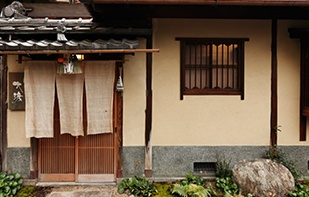
Phone: 075-551-5252
- Address:
- 570-265 Gionmachi Minamigawa, Higashiyama-ku, Kyoto-shi, Kyoto
- Open:
- Dinner 18:00 to arrival no later than 21:00
- Closed:
- Irregularly
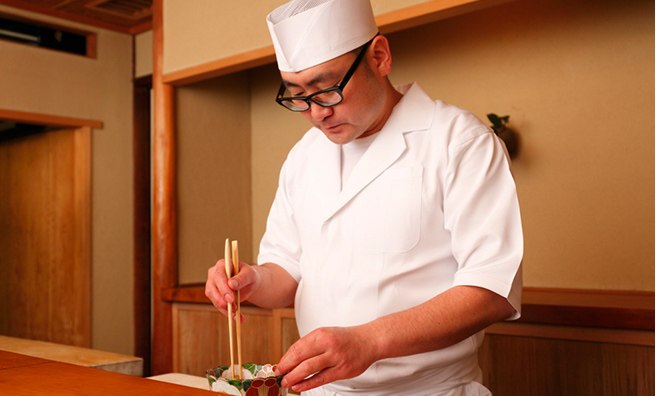
Owatari is well versed in tableware ranging from the Edo era to the current day. Seldom conventional, he serves sake in Lalique or Baccarat glasses.
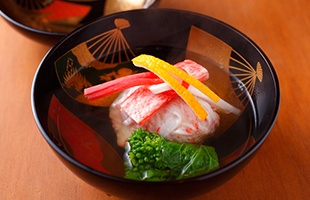
Hamasaka snow crab soup meatballs are boiled in brine, then rapidly chilled to bring out their delicious sweetness.
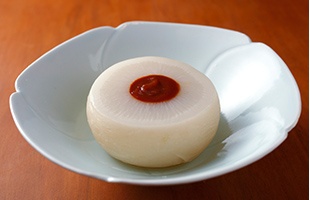
Flavorful Keihoku kabura turnips are boiled in nothing but crystal clear spring water from the Shimogoryo Shrine.
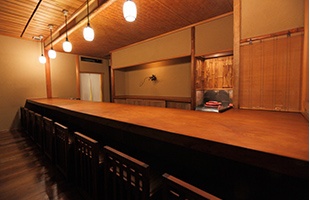
Owatari converted a private home in the back alleys of Gion to create a tranquil, settled atmosphere that complements his culinary creativity.
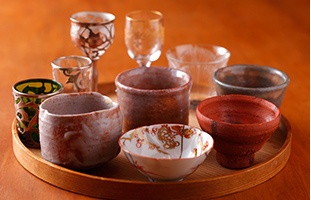
Customers can choose excellent sake from local and national brewers, served in their preferred cup or goblet.
Even the flavor of water is crucial to this up-and-coming chef.
Boiled kabura turnips speak volumes about Mahito Owatari, the increasingly renowned Kyoto chef with finely honed senses and a passion for flavor. While the dish is stunningly simple, it's considered a culinary masterpiece. He fills the scooped center of the locally grown turnip with white miso simmered and stirred for 5 hours until caramelized. It's a match made in heaven. The skin serves as a shell as customers excavate the flesh with a spoon.
"Since kabura turnips taste best at this time of year, I only cook them in water. And I only use water from Shimogoryo Shrine," says Owatari." In response to the surprise of his guests, he explains "If you really want to relish the taste of kabura turnips, even stock can interfere". Kyoto has a reputation for excellent water and he uses only the best. But when Owatari first came to Kyoto, after training in Osaka, he found the local water a problem.
"The water in Kyoto is so good that my soup stock was too rich," he says. "I couldn' t achieve the right flavor until I tried over and over again and finally discovered the magic of dried tuna flakes. Their mild and refined flavor made all the difference." Still, Owatari avoids using stock when pristine local water will suffice. He continues to refine his recipes in a quest for flavorful perfection.

Phone: 075-551-5252
- Address:
- 570-265 Gionmachi Minamigawa, Higashiyama-ku, Kyoto-shi, Kyoto
- Open:
- Dinner 18:00 to arrival no later than 21:00
- Closed:
- Irregularly
Muromachi Wakuden室町和久傳
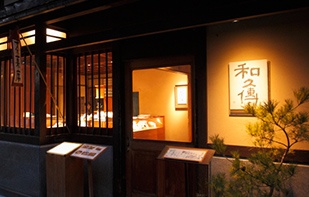
Phone: 075-223-3200
- Address:
- Higashigawa Oikekudaru, Sakaimachi-Dori, Nakagyo-ku, Kyoto-shi, Kyoto
- Open:
- Lunch 11:30 to arrival no later than 13:30
Dinner 17:30 to arrival no later than 20:00 - Closed:
- Tuesdays
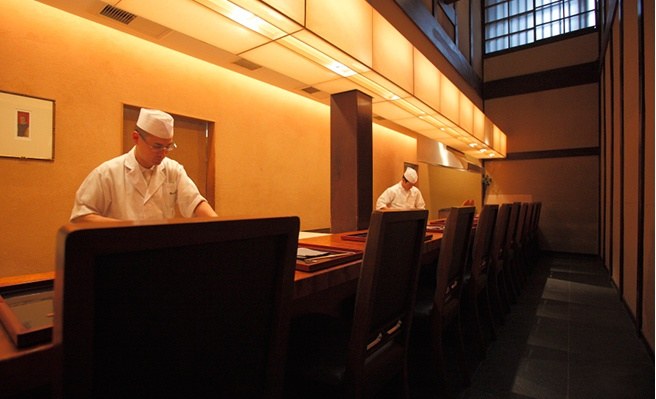
Customers can choose from private rooms with entertainment, western-style tables facing the courtyard or counter seats where chef manager Fujiyama personally prepares meals.
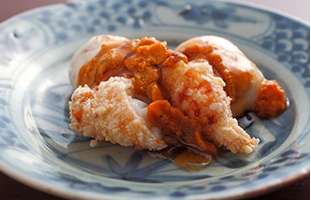
Caridean shrimp fritters from Tango, sprinkled with grated rice crackers before frying, are a light, crispy delight served with sea bream roe, sea urchin and soy sauce.
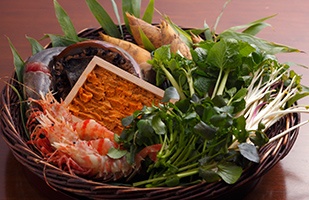
Fresh seasonal favorites like sea urchins, bamboo shoots, shrimp and black abalone are served in generous portions.
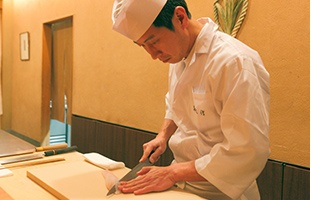
Chef manager Takao Fujiyama demonstrates his masterful skills. He only uses seasonal ingredients of the highest quality from Kyoto and the Tango district.
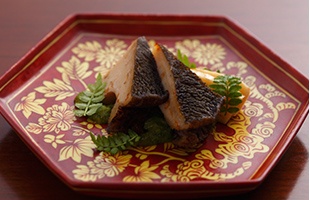
Lightly simmered black abalone from Tango with bamboo shoots, field mustard sauce and fresh Japanese pepper leaves.
Rustic yet refined. The essence of Kyoto Cuisine.
Muromachi Wakuden is one of Japan's leading Japanese restaurants. Chef manager Takao Fujiyama mastered Japanese cuisine in Kiyamachi before entering Muromachi Wakuden at the age of 24. He still vividly recalls the experience. "I worked with the finest quality ingredients and learned to be bold, rather than stingy. When the ingredients were flavorful, I threw a fastball rather than a curve. That’s what I learned at Wakuden. Fusing the natural taste of quality ingredients with the subtle preparation of Kyoto cuisine was exactly the direction I was seeking. Ebr> Fujiyama rapidly climbed the ladder from mid-level Mukouita staff to Hanaita chef manager. Over the last 15 years, he has divided his time between Wakuden's Muromachi and Koudaiji branches. Both are standout establishments and Fujiyama feels fortunate. “I haven’t changed my way of thinking since the day I entered Wakuden. Rustic yet refined cuisine Ethat’s still my philosophy. Ebr> Originally an inn, Wakuden was located in the Tango district of Kyoto and served seafood and vegetables delivered directly from local beaches and farms. The food was straightforward, with minimal decoration but a sophisticated Kyoto taste. Chefs had absolute confidence in the quality of the ingredients and knew how to bring out their finest qualities. This tradition lives on at Wakuden restaurant, which takes pride in preserving Kyoto's culinary culture.

Phone: 075-223-3200
- Address:
- Higashigawa Oikekudaru, Sakaimachi-Dori, Nakagyo-ku, Kyoto-shi, Kyoto
- Open:
- Lunch 11:30 to arrival no later than 13:30
Dinner 17:30 to arrival no later than 20:00 - Closed:
- Tuesdays
Gion Aji Fukushima味ふくしま
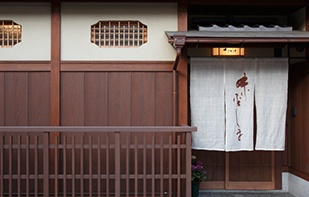
Phone: 075-561-4848
- Address:
- 570 Gionmachi Minamigawa, Higashiyama-ku, Kyoto-shi, Kyoto
- Open:
- Lunch 11:30 to arrival no later than 13:00
Dinner 17:00 to arrival no later than 20:00 - Closed:
- Sundays and the last Monday of the month
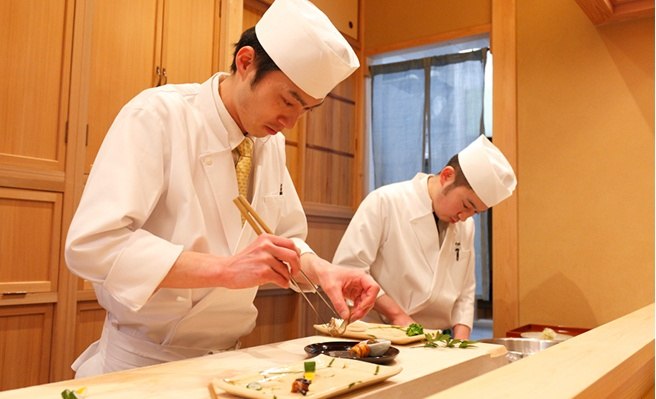
Young chef manager Tsuji frequently travels to meet farmers offering special produce. “I want to support the success of Japanese farmers and cuisine."

Assorted Hassun appetizers, including eel rolls, squid with fern, gudgeon from Lake Biwa, butterbur sprout with miso and field mustard with mustard dressing.
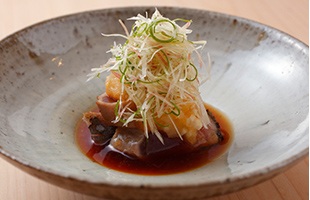
Bonito Tataki is grilled over hay rather than charcoal to infuse a pleasing aroma and refreshing flavor.
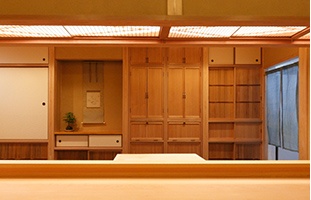
The counter is one solid piece of Japanese cypress, contributing to the dignified atmosphere of Aji Fukushima.

The restaurant is in the capable hands of lead chef Yoshikatsu Tsuji and owner Tomoko Fukushima of Fukushima geisha house.
Quality pursued with passion in today's Kyoto.
Hay-roasted Bonito tataki, exquisite while the skin is warm. Icefish egg custard soup. Tsukahara bamboo shoots picked fresh the same morning and served with green seaweed in thick sauce. Every dish is scrupulously prepared at Gion Aji Fukushima, which has earned its first Michelen star less than a year from its launch thanks to the forthright guidance of lead chef Yoshikatsu Tsuji.
"When you see the faces of the farmers and personally select their finest produce, you can't help but feel confident about your cuisine," says Tsuji. He travels far and wide to meet farmers offering the best produce, and returns with bounties of fresh, delicious ingredients. While many chefs use seasonal ingredients, chef Tsuji goes to admirable extremes. He was trained at renowned Oryori Hayashi in Kyoto and knows how to bring out the full flavor of vegetables, soup stocks and meats.
The restaurant is two blocks south of picturesque Gion Hanamikoji street and run by local Fukushima geisha house. It was built in the traditional Sukiya style, with a natural Japanese cypress counter and refined, unadorned atmosphere only found in Kyoto. A perfect stage for the talent and passion of its promising young chef, Aji Fukushima truly represents the new face of Kyoto.

Phone: 075-561-4848
- Address:
- 570 Gionmachi Minamigawa, Higashiyama-ku, Kyoto-shi, Kyoto
- Open:
- Lunch 11:30 to arrival no later than 13:00
Dinner 17:00 to arrival no later than 20:00 - Closed:
- Sundays and the last Monday of the month
Wagokoro Izumi和ごころ 泉
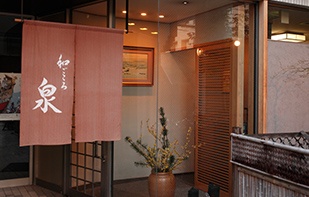
Phone: 075-351-3917
- Address:
- Shijo Shikishima Building 1F, 366 Shijo-cho (South of Shijo Shinmachi Intersection), Shimogyo-ku, Kyoto-shi, Kyoto
- Open:
- Lunch 11:30 to arrival no later than 13:00
Dinner 17:30 to arrival no later than 19:30 - Closed:
- Wednesdays

Hassun appetizers for two, a delight to the senses, include chirashi zushi, Sanuki-style marinated blood clams, boiled Kawachi duck with field mustard, roasted Kameoka beef rump, egg cakes and runner beans cooked in honey.
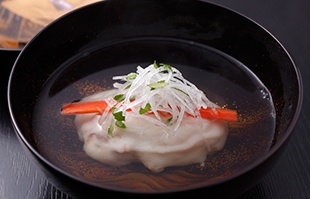
Kuwana clam cake soup with Japanese asparagus and pepper leaves.
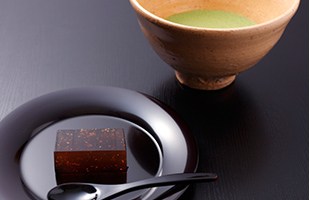
Elegant black soybean jelly accented with gold flakes.
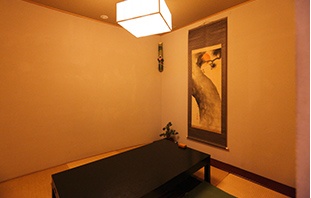
Three private rooms are available for quiet relaxation with friends or family. Children are welcome.
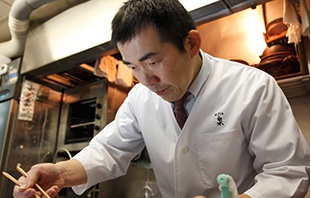
Masaki Izumi carries on the culinary tradition of renowned Sakurada restaurant, which closed much to customers' regret.
The very soul of Kyoto culture and cuisine.
"I used to visit potters in my free time," chef owner Masaki Izumi cheerfully responds when asked about the splendid ceramics framing his cuisine. His collection, amassed since his teens, includes 400-year-old underglazed blue ceramics, masterpieces by Living National Treasure Yuzo Kondo and the works of contemporary artists.
Izumi believes the essence of Japanese cuisine lies in its seasonal nature. So he surrounds customers with seasonal reminders ranging from the themes on his vases and ceramics and to the scrolls hanging from his walls. He focuses on presentation, as well as flavor, to fully convey the art of Japanese cuisine.
"I visit farmers and fishermen so I can speak with them face-to-face and more effectively communicate what I need," Izumi explains. He knows that quality varies significantly depending on wide-ranging factors. So he visits bonito fishermen in Makurazaki and travels far to find duck meat he can confidently serve raw. His menu includes rare clams from Kuwana, thanks to personal connections with Kuwana fishermen.
Every dish is thoughtfully prepared in a gracious atmosphere. His meats and seafoods include hidden slits that support carefree dining pleasure. It's a culinary experience and more, fulfilling body and soul.

Phone: 075-351-3917
- Address:
- Shijo Shikishima Building 1F, 366 Shijo-cho (South of Shijo Shinmachi Intersection), Shimogyo-ku, Kyoto-shi, Kyoto
- Open:
- Lunch 11:30 to arrival no later than 13:00
Dinner 17:30 to arrival no later than 19:30 - Closed:
- Wednesdays
*Articles are written based on information available at the time of publication.
More restaurants



